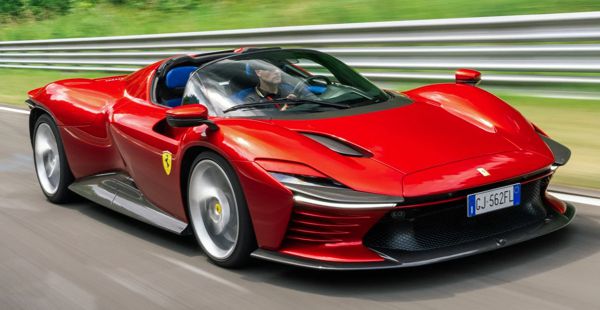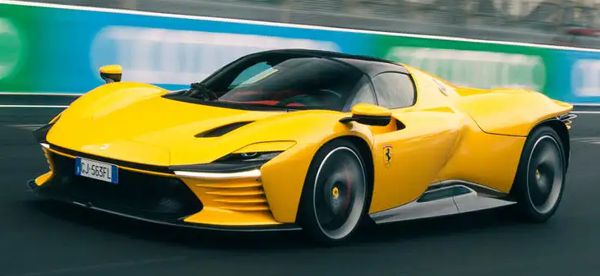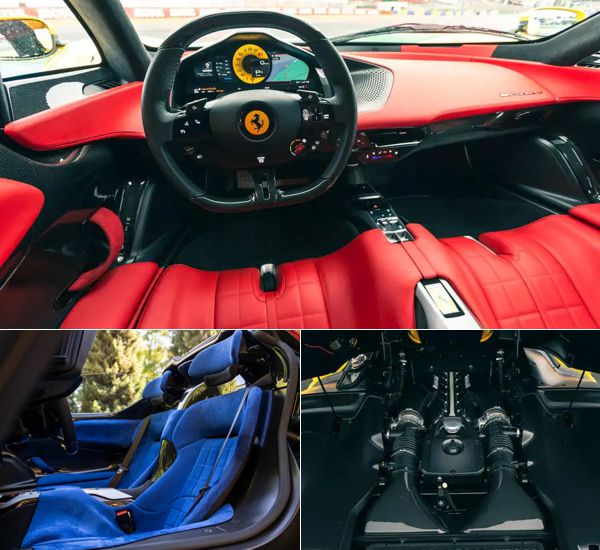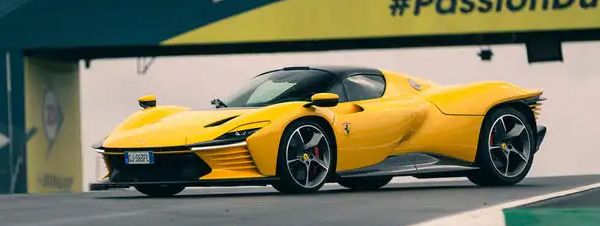| Published
on 7
Nov
2022 |
All rights reserved.
|
|
|
 |
|
Icona
models take inspiration from the past, but they might be the future of
Ferrari.
|
|
The days of selling
combustion cars are numbered. Not only CO2
emission regulations are tightening sharply, but EU has already decided
to end sales of combustion engine cars from 2035. There is a slim hope
that they could give “sustainable fuel” produced in carbon neutral
process an exemption. Even so, such fuels will be expensive and limited
in supply. In the end, only the richest people may continue to enjoy
traditional motoring, listening to good old induction howl and exhaust
note. From this perspective, you can imagine the future of our motor
industry: supercar makers like Ferrari and Lamborghini will convert the
majority of their cars to pure electric power, but they may keep their
best V12s from extinction by using them in ultra-expensive and
exclusive line of exotica. These will be priced in terms of million
dollars, if not tenths of million, with production limited to a few
hundreds a year, be designed and engineered to please traditionalists.
They won’t be as quick as their electric siblings, but their very
wealthy buyers won’t care, because they already have a 2000 or 3000
horsepower electric supercar from the same brand in their huge garages.
These combustion supercars are very likely to go retro in design, or
even turn to restomod, taking inspiration from historic models. Hybrid
power will be reverted to pure combustion engines. Dual-clutch
transmission may regress to manual gearbox, with elegant metal gate and
visible shift linkage. Chromed gauges and toggle switches may return,
if not wooden steering wheel, although a modern touchscreen and
infotainment system will be stored invisibly and pop out with the touch
of a button. Interesting future?
In fact, the future has been taking shape for some time. 3 years ago,
Ferrari started the "Icona" line of limited edition with Monza SP1 and
SP2. Both were based on the mechanicals of 812 Superfast but got rid of
windscreen and roof and were styled to mimic classic race cars like 250
TR. Production was limited to 500 units and each cost 1.6 million euros
before tax. Even more expensive than LaFerrari.
 |
|
840
horsepower V12 comes from 812 Competizione. It's the first pure V12
mid-engined Ferrari since Enzo.
|
|
Daytona SP3 is the third act. This time not just a reskinned 812, but a
mid-engined V12 supercar with unique design and engineering. Styling is
said to be inspired by the 330 P3 and P4 race cars that crushed Ford
GT40 in the 1967 Daytona 24 Hours with a 1-2-3 triumph, a sweet revenge
of the defeat in Le
Mans the previous year. Many reckon these were the most beautiful
Ferrari race cars ever made, thanks to a sexy waistline and wraparound
windscreen. Does the Daytona SP3 look like them? I am not sure. There
are certainly some elements mimic the classic, most notably the heavily
pronounced front and rear fenders. It sports a wraparound windscreen,
too, but look closer and you will see it is actually a conventional
windscreen welded to a pair of quarter windows. The carbon-fiber
A-pillars are still there, because it needs to take care of modern
safety regulations. The tail is stylishly decorated with horizontal
grilles like the P3 and P4, but to me it looks even closer to the same
feature on the 1985 Testorossa. Anyway, the SP3 is undoubtedly a very
beautiful car – sexy, stylish and almost like a concept car. It is also
incredibly wide, not just exaggerated by broad shoulders and relatively
narrow passenger cell, but it is really that wide, spanning 2050 mm
across shoulders.
Predictably, the exotic looks brings an even higher price – 2 million
euros before tax. Even so, all 499 cars slated for production have been
spoken for before its announcement. The Icona line is obviously
reserved
for loyal customers only.
 |
|
Design
inspired by the 1967 330 P3 and P4, reckoned to be the most beautiful
race cars Ferrari ever built.
|
|
For an iconic car like this, exclusivity, looks and feel are more
important than outright performance, therefore it does not seek to
better LaFerrari. Basically, you can see it as a LaFerrari stripped of
electric power. Serving it is Ferrari’s finest 6.5-liter naturally
aspirated V12, codenamed F140HC. It is sourced from 812 Competizione,
but gets bespoke intake and exhaust system to fit into the middle
engine bay. As in that car, the engine gets titanium con-rods,
diamond-like carbon coating on piston pins and cam lobes and a lighter
crankshaft for a 9500 rpm redline. Straighter and shorter exhaust is
probably why it could muster another 10 horsepower for an astonishing
840 hp, released at equally incredible 9250 rpm. Peak torque inches up
to 514 pound-foot, available at 7250 rpm, which is higher than many
performance car engines can ever rev to. Its is peaky, but still
tractable at low revs. Power is delivered linearly across the very wide
rev band, unlike modern turbocharged engines that give you full punch
from 3000 or 4000 rpm. For sure it will be exciting to exploit.
To add more emotion, Ferrari deliberately recalibrated the LaFerrari’s
7-speed DCT such that it shifts more aggressively at Race mode,
exaggerating the kick during each gearshift, even though that is not
the fastest way to change gears. The car is good for more than 211 mph,
0-60 mph in traction-limited 2.8 seconds and 0-124 mph in 7.4 seconds –
the latter trails 296 GTB by a tenth and LaFerrari by half a second,
but again that is not the most important.
 |
|
Seats
molded to carbon-fiber tub, same as LaFerrari.
|
|
The chassis is
built on the carbon-fiber tub of LaFerrari Aperta (the open-top
version). However, some places have been strengthened to cope with new
safety regulations. Despite ditching electric motor and battery, it
runs the same 2650 mm wheelbase. Like LaFerrari as well, the seats are
molded directly on the carbon tub to save weight and allow a lower
seating position. As compensation, the pedal box and steering wheel are
adjustable to fit the driver, while seats are tailored to each buyer.
The digital instrument comes from 296 GTB. The cockpit features a targa
roof. When opens, the roof panel has nowhere to store. There is a small
compartment up front to hold a toolbox and an emergency fabric roof
cover. This is not just a Sunday car but also a sunny day car. It is
not a shopping car either, as there is no luggage compartment. Then
again, all these are not important to such a car.
Oddly, even though devoid of hybrid power and the body work is full
carbon-fiber (or Kelvar), the SP3 weighs significantly more than
LaFerrari at 1485 kg dry, or about the same weight as the production
812 Competizione. At least, the weight is well distributed, 44 to 56
percent front to rear in typical mid-engined supercar fashion. At 124
mph, the body work will add another 230 kg load in the form of
downforce. Ferrari said it is the most aerodynamic efficient design it
has ever created for cars with passive aero. Yes, it does without any
active aerodynamics aids, rare to Ferrari these days. But then again,
downforce or lap time is not important to this car.
So what is important? The looks, the feel, the sound and the sense of
occasion, of course! From how difficult to get into its cockpit through
the small door aperture (and somewhat blocked by the triangular quarter
window), your first impression is ah, this is a very special car
indeed. You sit low and sense your bum becomes part of the chassis,
have a direct connection with the car through every gearshift and bump
and vibration. Your legs slide into a narrow footwell as if wearing the
carbon-fiber car as armour. Facing you is the familiar steering wheel
with all the controls packed onto it, including the Manettino rotary
drive mode selector. The digital instrument is new though, quite
complicated but colorful and configurable. The view forward is mega,
sandwiched by the curvy flanks as in the classic race car.
 |
|
Rawer
and edgier than lesser Ferraris, and that's what make it an icon.
|
|
Start the V12 motor and it immediately impresses. It is not very
torquey low down, nor very sonorous, so you are tempted to explore the
upper part of its wide rev range. It pays back with immediate response,
spins freely and smoothly while pulling harder and harder. From 6000 to
9500 rpm its sound becomes so addictive, a symphony of induction,
mechanical noise and exhaust pulses, not unlike Ferrari’s naturally
aspirated F1 engines in the early 2000s. Every downshift triggers an
angry bark that sounds more natural and satisfying than artificial pops
and crackles. The SP3 brings back the smile you lost in panic when
driving modern turbocharged cars. Its linear power delivery and natural
noise are here to help you and inspire you, not to shock you.
The chassis is also superb, although not without flaws. The ride is
surprisingly livable for a supercar looks this like a race car. Bump
mode and front axle lift help it deal with really bad surfaces. The
steering, still electrohydraulically assisted, is typical Ferrari, very
quick, quite light but responds to input precisely. You will get used
to it quickly. The brakes require more pedal effort than most modern
Ferraris, but give a classical feel. On dry roads, the SP3 produces
tremendous grip. High speed stability is also very good due to the
downforce. However, with a big V12 behind, it is not as agile as a 296
GTB or F8 Tributo. Despite the first adoption of FDE (Ferrari Dynamic
Enhancer) program on a mid-engined V12, it does not balance as well as
the LaFerrari, perhaps due to the additional weight, or simply because
it lacked the development required for a more serious model. It feels
somewhat old-school in handling, easier to slide with CT-off and edgier
to drive at the limit. On a wet road, you need to be brave or silly to
turn electronic aids off. Coupling to the immense width, it is not
quite as exploitable as lesser Ferraris. In many ways, it feels like an
F512M versus F355 in 1994, i.e., the bigger and more powerful is not
necessarily the better.
But back to our tag line, it is not important. The Daytona SP3 feels
rawer and more difficult to tame, and that’s why it is set to be an
icon, just like James Dean.
|
Verdict:     |
|